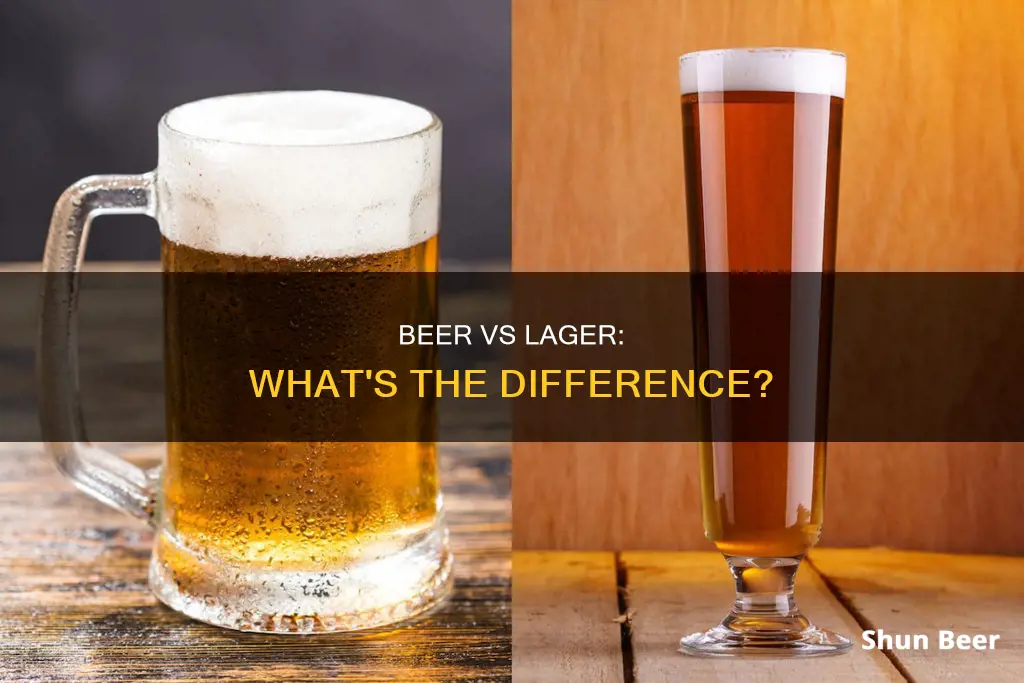
Beer and lager are two different things, but all lager is beer. Beer is the name given to a group of alcoholic drinks that include lager and ale. Lager is a German word that means storage, which hints at its brewing method. Lagers are beers that are fermented slowly at low temperatures and from the bottom up. Ales, on the other hand, ferment quickly from the top down and are brewed in a warm environment.
What You'll Learn

Lager is a type of beer, brewed at cool temperatures
Lagers are brewed with bottom-fermenting yeast, which works at cooler temperatures and settles at the bottom of the beer. The temperature range for lager fermentation is typically between 44-55°F (7-13°C). Ales, on the other hand, are brewed with top-fermenting yeast, which ferments at higher temperatures and settles at the top of the beer. The warmer fermentation of ales produces more esters, which give them a stronger and sweeter flavour than lagers.
The birth of the Pilsner style in the 1800s introduced much of the world to lagers. Before then, almost all beer was ale since yeast was not known as an ingredient and cold fermentation was difficult. The ability to see yeast strains under a microscope and the advent of refrigeration in the 19th century changed the course of beer history. The late 19th and 20th centuries saw the dramatic rise of lager beer, with its mellow taste and lower alcohol content.
Today, there are two main categories of beer: lager and ale. However, the distinction between the two has become blurred, especially in non-English speaking countries, where there is often no specific word for lager or ale. When ordering a beer, you may be given a lager, an ale, or another type of beer such as an IPA or stout.

Ales are fermented with top-fermenting yeast at warm temperatures
Top-fermenting yeast is used in the ale brewing process, which occurs in a warmer environment. The yeast ferments at higher temperatures and settles at the top of the beer. This results in a foamy layer forming on top during fermentation. The warm fermentation of ales produces more esters, which contribute to the sweeter and stronger flavour profile typically associated with ales.
The ale fermentation and ageing process is relatively short, typically taking 3-5 weeks. This is due to the warmer fermentation temperatures, which allow the yeast to work more rapidly. The shorter production time makes ale a more convenient choice for small breweries with limited fermenter space.
The use of top-fermenting yeast and warm temperatures in the brewing process gives ales their distinct characteristics. The specific temperature range and fermentation method influence the flavour, aroma, and overall character of the beer.
In summary, ales are defined by their use of top-fermenting yeast and warm fermentation temperatures. This results in a unique fermentation process, flavour profile, and production timeline that sets them apart from other beer categories, such as lagers.

Lagers are cold fermented, using bottom-fermenting yeast
Lagers are cold-fermented, using bottom-fermenting yeast. This means that the yeast works at the bottom of the wort at a much lower temperature, typically between 35°F and 50°F (2°C and 10°C). Bottom-fermenting yeast is ideally functional at lower temperatures, and it ferments more slowly and less vigorously than ale yeast.
The term "bottom fermentation" was first used in Bavaria in 1420. Brewers in this region found that they could ferment and store beer in the cool caves at the foothills of the Alps, even in the summertime. The colder temperatures allowed a different type of yeast to emerge—one that could ferment at cold temperatures. This new yeast fermented more slowly and less vigorously, never formed much foam on the surface, and, when finished, sank quickly to the bottom of the vessel. From there, it was collected and used in the next batch of beer. Over time, the selection of yeast from the bottom of the vessel naturally favoured yeast types that precipitated well, and these became known as "bottom-fermenting" yeasts.
Bottom-fermenting yeast, also known as lager yeast, is a hybrid of Saccharomyces cerevisiae and a wild yeast from Patagonia called Saccharomyces eubayanus. Their offspring, Saccharomyces pastorianus, inherited the ability to thrive in colder temperatures.
Because bottom fermentation occurs at lower temperatures, it requires longer fermentation times, often 10 to 14 days. Lower temperatures slow down the rate at which the yeast consumes sugars in the beer. To increase contact between the beer and yeast, breweries specialising in bottom fermentation often use short and wide fermenting vessels and sometimes install platforms in the vessel to catch the precipitating yeast.
Lager yeast also requires a higher initial volume of healthy yeast to reduce yeast stress. A cooler fermentation is a slower fermentation, and sluggish yeast can produce more undesirable compounds than they can sufficiently "clean up" without enough healthy yeast and a vigorous fermentation.

Pilsners are a type of lager, with a heavier hop flavour
Beer and lager are often used interchangeably, but there are some differences between the two. Beer is an umbrella term that includes lager, IPA, ale, and other styles of beer. Lager, on the other hand, is a specific type of beer that is brewed at a cool temperature using bottom-fermenting yeast. Pilsner is a type of lager, named after the Czech city of Plzen. The key difference between lager and pilsner is that pilsners have a more pronounced hop flavour and use a different type of yeast.
Pilsners, or pilsner-style beers, are characterised by their dry, crisp, and spicy flavour profile. They are often described as "a harmonic link between the old and the new world". Pilsners tend to be more hop-forward than other lagers, but they are not as hoppy as IPAs. The classic Czech and German pilsners are moderately hoppy compared to other lagers, but they still stand out within the lager family.
Italian pilsners, for example, are known for having more hop flavour than traditional pilsner varieties while maintaining the classic dry, crisp profile of a pilsner. This unique style of pilsner was created by Agostino Arioli, who was trained in the classical German style but heavily influenced by the dry-hopped cask ales of England. Arioli founded his brewery, Birrificio Italiano, in the Lombardy region of Italy and created a pilsner that was very lightly dry-hopped, called Tipopils, or "kind of pils."
Brewers have been experimenting with different ingredients and processes to create new variations of pilsners, showcasing the versatility of this lager style. For example, modern American interpretations of Italian pilsners are more aggressively dry-hopped, sometimes with a slightly higher ABV to balance the malt character. These innovative pilsners blur the line between hoppy lager and Italian pilsner, offering a unique twist on the traditional style.

Stouts are typically dark beers with a high alcohol content
To answer your question about the differences between beer and lager, it's important to understand that lager is a type of beer. So, when you order a lager, you'll get a specific drink, but if you order a beer, you might receive a lager, IPA, stout, or another type of beer.
Now, onto stouts. Stouts are typically dark beers with a high alcohol content. They are called stouts because they are strong and have a robust flavour. The word "stout" was first used to describe a beer in a 1677 document, where it referred to the beverage's strength. Historically, stouts were stronger versions of porters, and the two styles are closely linked.
Stouts are characterised by their dark colour, which comes from a high dark malt content. They also have a higher malt and lower hop content than lagers, contributing to their distinctive flavour profile. Stouts are typically fermented at the top, at temperatures between 18-20°C, while lagers are fermented at the bottom at much cooler temperatures of 0-2°C.
Stouts have a wide range of alcohol content, with some being highly drinkable and others being quite strong. Some well-known stouts, like Guinness Draught, have a relatively low alcohol content of around 4-5%. However, there are also Imperial Stouts, which have a much higher alcohol content, typically over 9% ABV. These stronger stouts are often aged in barrels, contributing to their high alcohol content.
Stouts are known for their complex flavours, which can include notes of chocolate, coffee, caramel, and roasted malts. They often have a creamy mouthfeel and a subtle bitterness, making them a popular choice for beer enthusiasts.
Frequently asked questions
Lager is a type of beer, so all lager is beer but not all beer is lager. Beer is a general term that can refer to lager, IPA, ale, or any other style of beer.
The key difference is in their fermentation process. Lager is produced through a method called bottom fermentation, which occurs at cooler temperatures and uses a specific yeast strain. Ales, in contrast, are produced through top fermentation at warmer temperatures.
The different production methods result in different tastes. Lager typically has a cleaner, crisper, and smoother flavour. Ale has a wider range of flavours and styles, from bitter to sweet, and can include fruity, spicy, or malty notes.
Examples of beer include ale, stout, porter, and India Pale Ale (IPA). Common examples of lager include pilsner, Märzen, bock, and helles.







